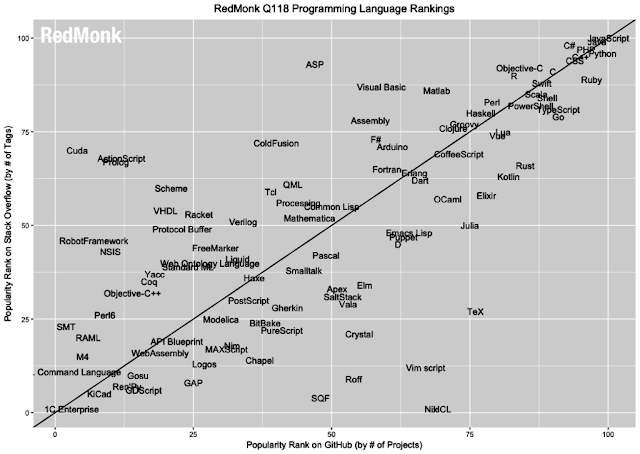While Kotlin is rising in the rankings
On March 7, RedMonk released its popularity ranking of programming languages for the first quarter of 2018. Before going any further, note that the RedMonk ranking is one of the best-known initiatives to introduce the "best" languages the most "popular" programming or languages, with the Tiobe index, PyPL or the annual ranking of the Institute of Electrical and Electronics Engineers (IEEE). And like all these initiatives, the RedMonk ranking has its limits.
For information, RedMonk combines data from GitHub and Stack Overflow: GitHub Archive which provides a record of all public events on GitHub allows to have the languages used for each project, and the data mining tool of Stack Overflow allows to extract the number of tags associated with a given language. It should also be noted that on GitHub, RedMonk does not consider forks.
The goal of RedMonk is not to offer a statistically valid representation of the current use of different languages, but rather to highlight a correlation between the discussion around a language (Stack Overflow) and the use of the language. language (GitHub) in order to extract information on potential future adoption trends. That said, what does the ranking reveal for the first quarter of 2018?
As the graph above can be difficult to analyze, here is more clearly the classification of RedMonk, at least the top 20:
1 JavaScript
2 Java
3 Python
4 PHP
5 C #
6 C ++
7 CSS
8 Ruby
9 C
10 Swift
10 Objective-C
12 Shell
12 R
14 TypeScript
14 Scala
16 GB
17 PowerShell
18 Perl
19 Haskell
20 Lua
Compared to his previous rankings, RedMonk explains that there is not much to say in the top 10, as it has remained static. Even with the arrival of new so-called future languages, languages already well established (such as JavaScript, Java, Python, PHP, C #, C ++) continue to lead the dance. On the other hand, it should be noted that for the first time, Swift manages to catch Objective-C in the RedMonk rankings. "Even though Swift has evolved at an incredible pace, Objective-C's history has kept it in front of its replacement. Finally, however, the trajectories had to cross, this quarter is the first one where this happened, "says RedMonk. "In a world where it is incredibly difficult to rank in the top 25 programming languages, not to mention the Top 10, Swift has managed the task in less than four years. It remains a growth phenomenon, even if its ability to penetrate the server did not meet expectations. It is outside the Top 10 especially that there are changes that RedMonk found useful to comment.
Is Google's Go language already out of breath?
According to RedMonk, Go has been one of the most dynamic languages observed. Very few other languages have been able to climb the Top 20 as fast as Go, which demonstrates its strong reputation as a back-end systems language. But Go seems to have reached a ceiling. "After staying in 15th place for two quarters, Go watched Swift pass him and for the first time in our rankings, he fell to 16th place," RedMonk said. The analyst firm says it does not recommend readers to rely on changes in ranking from one quarter to the next, even at the top of the rankings. However, she states that "[Go's] trajectory does not give much hope that Go will resume its rapid rise to the top in the near future." RedMonk explains that "if its reputation back end language is undeniable, Go lacks the versatility of comparable languages like Java that would allow it to access new markets and therefore new growth. "
What about Kotlin?
Admittedly, he is not yet in the Top 20 of RedMonk, but the analysis firm considers it as a language of the future. In just over a year, Kotlin has moved from 65th place to 27th place today. He did not match Swift's performance (who jumped from 68th to 22nd in half the time), but Kotlin is now the second fastest language after Objective-C's successor. According to RedMonk, this is due not only to the attractiveness of Kotlin for Java developers, but also to its elevation as a first class language for Android development.
PowerShell, R, TypeScript: three growing languages that have Microsoft support in common
They are all in the Top 20 and gain places in the RedMonk rankings: PowerShell (+1), R (+2) and TypeScript (+3). "Of all the providers on this list, Microsoft is by far the one who has something to boast about," says the analyst firm. "PowerShell continues its steady rise, and R has rebounded after slight declines earlier. TypeScript, meanwhile, managed a contextually impressive three-place jump from 17th to 14th place. Given that growth in the Top 20 is scarce, achieving the growth that a common language like R has recorded in our latest rankings is an impressive achievement. This could indicate, according to RedMonk, that "Microsoft is growing in three distinct categories: operations, analytics / data science and application development ... This is a strong indication that Microsoft's multi-language approach in the whole market is paying off. "
Moreover, Rust, the Mozilla language has continued its slow and steady rise, and manages to rank for the first time in the Top 25, in 23rd place. "This makes it more popular in the rankings than Clojure, Groovy, or Visual Basic, which is an important achievement for a language that is prized for its security, but is not considered easy to understand like other languages of the world. this list, "says RedMonk. Scala, for its part, fell for the third time in a row, this time losing two places in the standings to end up in 14th place. RedMonk does not find an explanation for this yet.
Source: https://redmonk.com/sogrady/2018/03/07/language-rankings-1-18/

